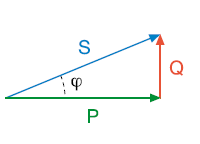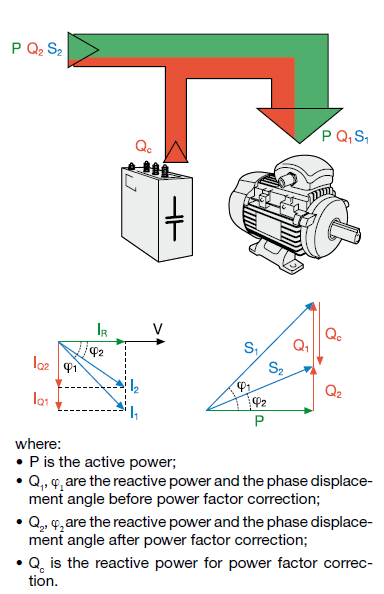PF Correction Basics
What is Power Factor?
In alternating current circuits, the current absorbed by a load can be represented by two components the active component and the reactive component. The active current is in phase with the voltage and contributes to useful work done by electrical machines. While the reactive current is in quadrature to voltage and is used to generate the flow required for the conversation of powers through electrical or magnetic fields.
Therefore, in an electrical installation, it is necessary to generate and transmit, in addition to the active power P, a certain reactive power Q, which is essential for the conversion of the electrical energy but is not available to the load because exchanged with the network. The complex of the power generated and transmitted constitutes the apparent power S.
Power factor cosϕ is defined as the ratio between the active component IR and the total value of the current I; ϕ is the phase angle between the voltage and the current.
For a given phase voltage V, it results:
Cosϕ = IR/I = P/S
S2 = P2 + Q2
Q = P tanϕ

As can be seen from the above power triangle representing the three powers, the higher the PF the lower is the apparent power and reactive power requirement drawn from the utility to do the same useful work.
Benefits of PF Correction
Technical Benefits
- Better utilization of electrical infrastructure
- Reduction in line losses
- Reduction of voltage drops
- Enhanced life of electrical equipments
- Compliance with utility prescribed minimum PF levels
Economical Benefits
Utilities either directly or indirectly impose penalties on drawing power below a certain PF level and incentivises power consumption at improved PF as it helps them not only produce efficiently but also use infrastructure efficiently to service more consumers.
For industrial consumers significant economical benefits can be realized by improving PF. The following savings can be achieved:
- eliminating any PF penalties
- realizing the best possible PF rebates
- reduction in demand charges
For utilities that bill consumers based on KVAh do not provide for a PF penalty or rebate as the same is directly baked into the energy consumption as lower PF would result in higher unit consumptions and vice-a-versa.
Calculating Reactive Power Requirement
The reactive power required by the loads can be supplied by using suitable PF correction equipments which in turn provides the required reactive power leading to reduction or elimination of reactive power from the utility.
The reactive power requirement to improve the system PF can easily be calculated if we know the initial status and the target PF to be achieved post installation of the PF correction equipment.


Example:
A wood cutting factory wishes to increase its PF from 0.80 to 0.93. The factory has a current operating load of 380 KW. What size of capacitor banks should it install to help achieve the desired PF? Also what shall be the reduction in current due to installation of capacitor banks.
The reactive power requirement, can be calculated using the formula




PF Correction Solutions
There is wide range of possible products and solutions to choose from, including but not limited to
- Fixed Capacitor Banks
- APFC Panels
- RTPFC Panels
- Outdoor HT Capacitor Banks
- HT Metal Enclosed Capacitor Banks
- HT APFC
- Static VAR Generator (SVG)
- Hybrid Panels
- SVC (Satic Var Compensators)
- STATCOM
PF Correction & Harmonics
In the presence of harmonics, true PF can be improved only by addressing not just the reactive power requirements but also the distortion reactive power requirements by eliminating harmonics. To know more read (PF correction article) or explore the subsequent article on selection of suitable PF correction solutions.
To learn more, follow the other articles that cover some of these subjects mentioned over in greater details.
 033-2231 8646/47
033-2231 8646/47 info@e-cube.in
info@e-cube.in